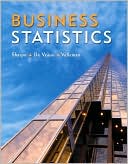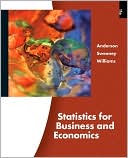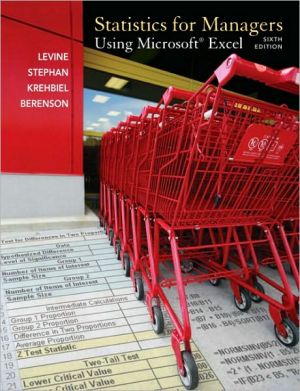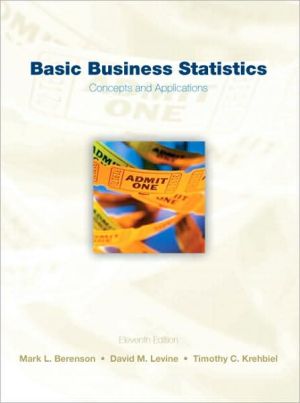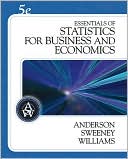Business Statistics
Search in google:
Professors Norean Sharpe (Babson College), Dick De Veaux (Williams College), and Paul Velleman (Cornell University) have teamed up to provide an innovative new textbook for business statistics. These authors have taught at the finest business schools, and draw on their consulting experience at leading companies to show readers how statistical thinking is vital to modern decision making. Managers make better business decisions when they understand statistics, and Business Statistics gives readers the statistical tools and understanding to take them from the classroom to the boardroom. Hundreds of examples are based on current events and timely business topics. Short, accessible chapters allow for flexible coverage of important topics, while the conversational writing style maintains interest and comprehension.EXPLORING AND COLLECTING DATA: Statistics and Variation; Data; Surveys and Sampling; Displaying and Describing Categorical Data; Randomness and Probability; Displaying and Describing Quantitative Data; UNDERSTANDING DATA AND DISTRIBUTIONS: Scatterplots, Association, and Correlation; Linear Regression; Sampling Distributions and the Normal Model; Confidence Intervals for Proportions; Testing Hypotheses about Proportions; Confidence Intervals and Hypothesis Tests for Means; Comparing Two Means; Paired Samples and Blocks; Inference for Counts: Chi-Square Tests; EXPLORING RELATIONSHIPS AMONG VARIABLES: Inference for Regression; Understanding Residuals; Multiple Regression; Building Multiple Regression Models; Time Series Analysis; BUILDING MODELS FOR DECISION MAKING: Probability Models; Decision Making and Risk; Design and Analysis of Experiments and Observational Studies; Introduction to Data MiningFor all readers interested in business statistics.
PART I: EXPLORING AND COLLECTING DATA1. Statistics and Variation2. Data2.1 What Are Data?2.2 Variable Types2.3 Where, How, and When3. Surveys and Sampling3.1 Three Ideas of Sampling3.2 A Census–Does it Make Sense?3.3 Populations and Parameters3.4 Simple Random Sample (SRS)3.5 Other Sample Designs3.6 Defining the Population3.7 The Valid Survey4. Displaying and Describing Categorical Data4.1 The Three Rules of Data Analysis4.2 Frequency Tables4.3 Charts4.4 Contingency Tables5. Randomness and Probability5.1 Random Phenomena and Probability5.2 The Non-existent Law of Averages5.3 Different Types of Probability5.4 Probability Rules5.5 Joint Probability and Contingency Tables5.6 Conditional Probability5.7 Constructing Contingency Tables6. Displaying and Describing Quantitative Data6.1 Displaying Distributions6.2 Shape6.3 Center6.4 Spread of the Distribution6.5 Shape, Center, and Spread–A Summary6.6 Five-Number Summary and Boxplots6.7 Comparing Groups6.8 Identifying Outliers6.9 Standardizing6.10 Time Series Plots*6.11 Transforming Skewed DataPART II: UNDERSTANDING DATA AND DISTRIBUTIONS7. Scatterplots, Association, and Correlation 7.1 Looking at Scatterplots7.2 Assigning Roles to Variables in Scatterplots7.3 Understanding Correlation*7.4 Straightening Scatterplots7.5 Lurking Variables and Causation8. Linear Regression8.1 The Linear Model8.2 Correlation and the Line8.3 Regression to the Mean8.4 Checking the Model8.5 Learning More from the Residuals8.6 Variation in the Model and R28.7 Reality Check: Is the Regression Reasonable?9. Sampling Distributions and the Normal Model9.1 Modeling the Distribution of Sample Proportions9.2 Simulation9.3 The Normal Distribution9.4 Practice with Normal Distribution Calculations9.5 The Sampling Distribution for Proportions9.6 Assumptions and Conditions9.7 The Central Limit Theorem–The Fundamental Theorem of Statistics9.8 The Sampling Distribution of the Mean9.9 Sample Size–Diminishing Returns9.10 How Sampling Distribution Models Work10. Confidence Intervals for Proportions10.1 A Confidence Interval10.2 Margin of Error: Certainty vs. Precision10.3 Critical Values10.4 Assumptions and Conditions*10.5 A Confidence Interval for Small Samples10.6 Choosing Sample Size11. Testing Hypotheses about Proportions11.1 Hypotheses11.2 A Trial as a Hypothesis Test11.3 P-values11.4 The Reasoning of Hypothesis Testing11.5 Alternative Hypotheses11.6 Alpha Levels and Significance11.7 Critical Values11.8 Confidence Intervals and Hypothesis Tests11.9 Two Types of Errors*11.10 Power12. Confidence Intervals and Hypothesis Tests for Means12.1 The Sampling Distribution for the Mean12.2 A Confidence Interval for Means12.3 Assumptions and Conditions12.4 Cautions About Interpreting Confidence Intervals12.5 One-Sample t-Test12.6 Sample Size12.7 Degrees of Freedom–Why (n-1)?13. Comparing Two Means13.1 Testing Differences Between Two Means13.2 The Two-Sample t-test13.3 Assumptions and Conditions*13.4 A Confidence Interval for the Difference Between Two Means13.5 The Pooled t-test*13.6 Tukey’s Quick Test14. Paired Samples and Blocks14.1 Paired Data14.2 Assumptions and Conditions14.3 The Paired t-Test14.4 How the Paired t-Test Works15. Inference for Counts: Chi-Square Tests15.1 Goodness of Fit Tests15.2 Interpreting Chi-square Values15.3 Examining the Residuals15.4 The Chi-Square Test of Homogeneity15.5 Comparing Two Proportions15.6 Chi-Square Test of IndependencePART III: EXPLORING RELATIONSHIPS AMONG VARIABLES16. Inference for Regression16.1 The Population and the Sample16.2 Assumptions and Conditions16.3 The Standard Error of the Slope16.4 A Test for the Regression Slope16.5 A Hypothesis Test for Correlation16.6 Standard Errors for Predicted Values16.7 Using Confidence and Prediction Intervals17. Understanding Residuals17.1 Examining Residuals for Groups17.2 Extrapolation and Prediction17.3 Unusual and Extraordinary Observations17.4 Working with Summary Values17.5 Autocorrelation17.6 Linearity17.7 Transforming (Re-expressing) Data17.8 The Ladder of Powers18. Multiple Regression18.1 The Multiple Regression Model18.2 Interpreting Multiple Regression Coefficients18.3 Assumptions and Conditions for the Multiple Regression Model18.4 Testing the Multiple Regression Model*18.5 Adjusted R2, and the Multiple Regression F-statistic*18.6 The Logistic Regression Model19. Building Multiple Regression Models19.1 Indicator (or Dummy) Variables19.2 Adjusting for Different Slopes — Interaction Terms19.3 Multiple Regression Diagnostics19.4 Building Regression Models19.5 Colinearity19.6 Quadratic Terms20. Time Series Analysis20.1 What is a Time-Series?20.2 Components of a Time Series20.3 Smoothing Methods20.4 Simple Moving Average Methods20.5 Weighted Moving Averages20.6 Exponential Smoothing Methods20.7 Summarizing Forecast Error20.8 Autoregressive Models20.9 Random Walks20.10 Multiple Regression-based Models20.11 Additive and Multiplicative Models20.12 Cyclical and Irregular Components20.13 Forecasting with Regression-based Models20.14 Choosing a Time Series Forecasting Method20.15 Interpreting Time Series Models: The Whole Food Data RevisitedPART IV: BUILDING MODELS FOR DECISION MAKING21. Probability Models21.1 Expected Value of a Random Variable21.2 Standard Deviation of a Random Variable21.3 Properties of Expected Values and Variances21.4 Discrete Probability Methods21.5 Continuous Random Variables22. Decision Making and Risk22.1 Actions, Stats of Nature, and Outcomes22.2 Payoff Tables and Decision Trees22.3 Minimizing Loss and Maximizing Gain22.4 The Expected Value of an Action22.5 Expected Value with Perfect Information22.6 Decisions Made with Sample Information22.7 Estimating Variation22.8 Sensitivity22.9 Simulation22.10 Probability Trees* 22.11 Reversing the Conditioning: Babyes's Rule22.12 More Complex Decisions23. Design and Analysis of Experiments and Observational Studies23.1 Observational Studies23.2 Randomized, Comparative Experiments23.3 The Four Principles of Experimental Design23.4 Experimental Designs23.5 Blinding and Placebos23.6 Confounding and Lurking Variables23.7 Analyzing a Design in One Factor - The Analysis of Variance23.8 Assumptions and Conditions for ANOVA*23.9 Multiple Comparisons23.10 Analysis of Multi Factor Designs24. Introduction to Data Mining24.1 Direct Marketing24.2 Data24.3 The Goals of Data Mining24.4 Data Mining Myths24.5 Successful Data Mining24.6 Data Mining Problems24.7 Data Mining Algorithms24.8 The Data Mining Process24.9 Summary*Indicates an optional topic
